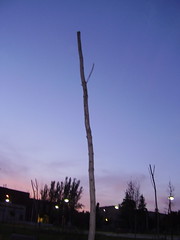After talking to my advisor for a while about summer research, I've decided to use the original idea for a database that George Alter suggested last month. I'm applying for funding for it next week. My proposal draft still needs to include a more thorough discussion of the methodology (George Alter suggested a few articles that I still need to read) as well as a more detailed description of what the database would be like. But it provides a general idea of how a database like this would really help address several problems in the historiography. So here is the general proposal, which I plan to keep working on throughout the semester in order to have the database ready to go for the summer.
Rough Draft - proposal
The overwhelming attention given to the development of progressive Catholicism in El Salvador in the wake of the Vatican II and Medellín has created a powerful historical narrative involving a "break" between traditional and progressive Catholicism, with the Pastoral Week of 1970 marking the split between two eras. Underpinning this narrative is the assumption of a two-tiered model of religion: elite and popular. Before the break, the Salvadoran Catholic Church was the defender of the status quo, providing a justificatory religious framework for the elites; after the break, the Church questioned the status quo by redefining sin as primarily social and structural and embraced the opposite side of the binary--"local," decentralized, or popular religion. Although in this narrative there is a distinction between progressive and "local" or popular religion, the former is seen as growing out of the latter, while shedding along the way "magical" or deterministic explanations of poverty and suffering. Less attention has been paid to clearly defining what is meant by "religion of the elites" or "traditional" Catholicism.
During the peak of Catholic Action involvement in the late 1950s and early 1960s, members of the clergy involved in the movement were effectively horrified at members' lack of Catholic instruction or understanding of the basic catechism. Underlying the assumption of the "break" there is an assumption of a widespread influence of "traditional" Catholicism, yet we have little knowledge of how Catholicism was traditionally practiced. To what extent was Catholicism a part of people's everyday lives in the mid-twentieth century?
Examining the influence of the Catholic Church in El Salvador in the years prior to the Pastoral Week of 1970 poses two related problems. Articles books, homilies and symbols will only get us so far: these sources only provide a vision of interactions within the institution and how it was struggling to present itself to the laity. They offer little insight into how the Church was perceived by other institutional actors like the military, and even less of how it was perceived by lay Catholics and non-Catholics, making it almost impossible to determine the degree to which its actions were greeted with acceptance, hostility, or indifference. How many people read those journals or listened to those homilies? How many people could read at all? Who cared? The most readily available sources are one-sided and tracking direct responses to these is, in most cases, impossible.
If it is true that there was a marked shift in the Church during the tenure of Archbishop Chávez y Gonzalez, one angle into the problem of how this shift was perceived is to track how people came into contact with the Church at an institutional level throughout their lives and if this changed in the twentieth century. By creating a database in my History and New Media class with semester, this summer I hope to begin a data collection project employing a methodology used primarily within the historiography of eighteenth century France in the years prior to the Revolution. The approach is quite simple: tracking the percentage of marriages carried out during Advent and Lent, two periods in the Catholic liturgical year of fasting and "preparation," in order to determine the degree to which "traditional" Catholic rituals were observed. The Church officially frowns upon getting married during these periods, as marriage is a celebration of union not in keeping with the penitential attitude demanded of observant Catholics. Whether or not Catholics were observant, oblivious, or indifferent to the most important periods of penance during the liturgical year can be broadly determined by examining if and to what extent they were getting married during Advent and Lent. In eighteenth century France, there is a correlation between the increasing number of such marriages and the Church's gradual loss of hegemonic authority as the first stage of the Revolution drew nearer. What will this tell us in the case of El Salvador?
First of all, it will simply tell us the extent to which El Salvador was a strictly observant Catholic country at all. This, in turn, will give us the tools to determine the degree of hegemonic authority that the Church wielded, broadly speaking, over the laity. Most importantly, it will allow us to examine how this changed both through time and in different dioceses. I propose to start my samples in the 1880s, when civil matrimony became an alternative to marriage through the Church, and continue into 1962, the year of the Second Vatican Council, with five-year intervals. I plan to compare the dioceses of San Miguel, San Salvador and Santa Ana as well.
The variables in a marriage certificate include profession, place of residence, age, witnesses, and name of priest. Gathering this kind of data will therefore also prove fruitful on other fronts. We will be able to consider correlations between class and church membership, compare differences in urban and rural areas, as well as determine the presence of priests in certain areas (and by analyzing the name, whether they were foreign born). In sum, examining such data will prove invaluable to understanding shifts that are difficult to track on the level of discourse alone.

